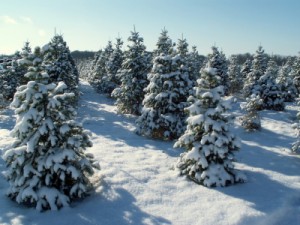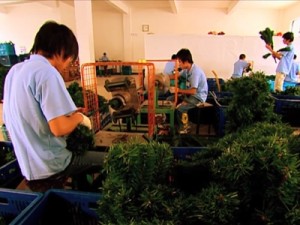O Christmas Tree II
Earlier in this series I discussed a little bit about the importance of the Christmas tree to the celebration of Jesus’ birthday. In that post we learned that the use of evergreen trees during the Christmas season is usually traced to the 1500s in Germany. It took until the middle of the 1800s for the custom to gain widespread popularity in the U.S. Today, Christmas trees are grown in all 50 states and more than 33 million of them will be sold this year. That is, 33 million plus REAL Christmas trees will be sold this year. An additional 9.5 million artificial trees will also be sold in 2013.
Which brings us to the point of this entry, real vs. artificial Christmas trees. We’ll look at the pros and cons of each type of tree from an objective standpoint. Or at least as objective a standpoint as I can muster, I do have some pretty strong feelings about this particular Christmas tradition.
We’ve already looked at the origins of using real trees for the celebration of Christmas, now let’s look at how artificial trees came into being. Germany was the birthplace of the first artificial Christmas trees which were made out of goose feathers that had been dyed green and attached to wire branches. The first mass-produced artificial Christmas trees were made in the 1930s by the Addis Brush Company, who were well known for their toilet brushes. In fact, Addis used the same materials and machinery to manufacture their trees, called the “Silver Pine,” as they did to make their toilet brushes. So once a Silver Pine had outlived its usefulness as a tree, its owners could use the branches to scrub out their toilet bowls.
For my family, and I’m sure this is true for thousands of families around the world, going to get the Christmas tree has become a favorite Christmas tradition. It’s like going on an adventure. Everyone bundles up and gets into the car, the anticipation rising the closer they get to the Christmas tree farm or lot. Once there, the entire family spreads out to explore the temporary forest of green looking for the perfect tree. They examine each specimen, looking for bald spots, testing the straightness of the trunk and examining the ground for tell-tale fallen needles. With the tree selected and secured to the roof of the car, it’s back home where the evergreen will be set in its place of honor.

Hot cocoa for each family member and some water for the tree and then the decorating begins. Lights first, strung top to bottom to ensure the plug is near the floor and an outlet. Then it’s on to the ornaments. This is one of the most precious of family traditions. Each decoration represents years of memories, from “Baby’s First Christmas” to construction paper reindeer made in the third grade and the green glass ball handed down from Great Grandma. And finally the star, or the angel, is placed on top of the tree and the lights are lit. “Oohs” and “aahs” fill the room as another Christmas season has begun.
Now, compare that to the “tradition” surrounding the artificial Christmas tree. Dad goes up to the attic or down to the basement, looks behind the water heater and drags the plastic bag enshrouded tree into the living room. The bag is removed, the lights plugged in and “whoopee” it’s Christmas.
There are other, perhaps less obvious, considerations when deciding between real and artificial Christmas trees. Like the environmental impact. Those first Addis Brush Company Silver Pines had “needles” made of animal hair. Today’s artificial Christmas trees are made mostly of metal or plastic which may contain lead and are petroleum-based. The life span of an artificial tree is between five and 10 years in the home, and hundreds of years in the landfill.

Real Christmas trees are 100% natural; they are trees, after all. A single acre of Christmas trees produces enough oxygen every day to sustain 18 people. With Christmas trees growing on about 350,000 acres, they produce enough oxygen for 6,300,000 people every day. And that’s just in the United States. And they are a renewable resource. On average, Christmas tree growers plant three new trees for every one that they harvest. After brightening a home for the Christmas season a real tree will return carbon, nitrogen and other nutrients to the soil as they decompose. Some communities recycle real Christmas trees in ponds and lakes, providing a sanctuary for fish and other aquatic life.
Let’s take a look at the economics of real vs. artificial Christmas trees. If you only consider the up front purchase price, the artificial tree may seem to have the edge. An artificial tree will last a family between five and 10 years, so that $150 or so (you can easily spend up to $1,000 on an artificial tree) spread over 10 years doesn’t look so bad compared to $50 or more every year for a real tree. But there’s more to it than just the purchase price.
Real Christmas trees purchased in America are grown in America and the money that changes hands stays in America. At least 85% of artificial Christmas trees are imported from China. China! Where they don’t even allow people to celebrate Christmas! And don’t get me started on the trade deficit and the role the artificial Christmas tree industry plays in that mess.
The real Christmas tree industry in America sells about 33 million trees every year. The nearly 15,000 Christmas tree farms in the U.S. and the retailers of Christmas trees employ over 100,000 people full- and part-time. Add to that the more than 4,000 Christmas tree recycling programs nationwide and it becomes painfully obvious that real Christmas trees provide a positive impact on the national economy.
So let’s total it up. Real Christmas trees are traditional, environmentally friendly, play a vital role in keeping our economy healthy and are patriotic. Artificial Christmas trees are none of those things. And the way they’re manufactured today, you can’t even use them to scrub your toilet bowl once they’ve outlived their usefulness as trees.
